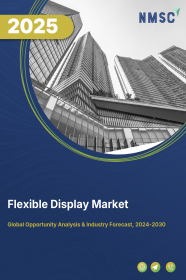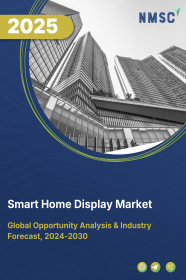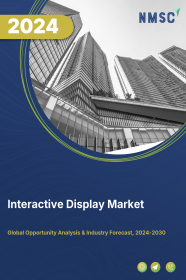
Flexible Display Market by Material (Glass, Plastic and Other Substrate Materials), by Type (OLED, LCD, LED, and EPD), by Component (Organic Material, Substrate, Conductive Layer, Backlight Panel, and Others), by Technology (Display Technology and Display Manufacturing Technology) – Global Opportunity Analysis and Industry Forecast 2023-2030
US Tariff Impact on Flexible Display Market
Trump Tariffs Are Reshaping Global Business
Market Definition
The global Flexible Display Market size was valued at USD 20.22 billion in 2022 and is predicted to reach USD 192.11 billion by 2030 with a CAGR of 32.54% from 2023-2030.
A flexible display also known as rollable display refers to a display technology that is designed to be bendable, rollable, or foldable, offering enhanced flexibility and versatility compared to traditional rigid displays. These displays are typically made using flexible materials such as plastic or Organic Light-Emitting Diode (OLED) technology, allowing them to be curved, twisted, or bent without causing damage. Flexible displays offer several advantages, including the ability to create unique form factors for devices such as smartphones, tablets, and wearable devices. They also enable the development of innovative products that includes foldable smartphones or rollable screens. The flexibility of these displays opens up new possibilities for design, user experience, and portability, making them an exciting and rapidly advancing area of display technology.
Market Dynamics and Trends
The demand for flexible display is rising due to fastest growing number of electronics devices that includes smartphones, laptops, smart television and smart watches across the globe. According to the report published by Gartner, there are more than 1.43 billion smartphones sold in 2021, which is nearly 80 million increases over 2020. The increased use of smartphones has resulted in a high demand for displays, thereby increasing the need for flexible display worldwide.
Moreover, growing demand for latest technologies, including organic light-emitting diode (OLED) and active-matrix organic light-emitting diode (AMOLED) display owing to easy design, better picture quality and flexibility specifications have been driving the growth of rollable display market. For instance, in April 2023, researchers at the University of Chicago developed a new type of OLED display that can be stretched and bent without breaking. The display is made up of organic molecules embedded in a stretchable polymer matrix. The stretchable OLED display can be used in a variety of applications, such as wearable devices, bendable smartphones, and even medical implants. The researchers are continuing to develop the display and explore new applications for it that is thriving the growth of the flexible display industry.
In addition, increasing tough competition among the manufacturing companies has led to technological advancements that include quantum dot light emitting diode (Q-dot LED) is expected to further propel the growth of the market. For instance, in January 2022, Sony launched its first quantum dot OLED (QD-OLED) smart TV and new mini-LED TVs at CES 2022. This product offers accurate colors of quantum dots and the deep blacks of OLED.
However, high cost associated with complex manufacturing procedures are the factors that restrain the growth of the market. On the contrary, introduction of automotive display and bendable smartphones are expected to create ample growth opportunities for the market in the coming years. For instance, in April 2023, Hyundai Mobis develops world's first rollable vehicle display that is made of flexible OLEDs that can be rolled up and down. It is designed for dashboards, infotainment systems, and head-up displays.
Market Segmentations and Scope of the Study
The flexible display market report is segmented on the basis of material, type, component, technology, application, and geography. On the basis of material, the market is divided into glass, plastic and other substrate materials. On the basis of type, the market is classified into OLED, LCD, LED, and EPD. On the basis of component, the market is categorized into organic material, substrate, conductive layer, backlight panel, and others. On the basis of technology, the market is segmented into display technology and display manufacturing technology. On the basis of application, the market is bifurcated into smartphones and tablets, smart wearables, televisions and e-reader, e-paper, digital signage systems, personal computers and laptops, monitors, vehicle and public transport and, smart home appliances. The geography breakdown and analysis of each of the aforesaid segments include regions such as North America, Europe, Asia-Pacific, and RoW.
Geographical Analysis
Asia-Pacific region is expected to hold the dominant share of flexible display market size and is expected to continue dominating the market during the forecast period. This is attributed to well established consumer electronics industry in the countries such as China, Japan, South Korea, and others propels the growth of the market. According to the Semiconductor Industry Association, China is the world's leading producer of electronics, accounting for 36% of global production. This includes smartphones, computers, cloud servers, and telecom infrastructure. China's dominance in the electronics supply chain is due to a number of factors, including its large manufacturing base, low labor costs, and government support for the industry.
Furthermore, presence of prominent players such as LG Display Co., Japan Display Inc., Samsung Electronics Co. and Panasonic Corporation are the key factors that drive the market growth in this region. For instance, in November 2022, LG Display revealed stretchable display that can be bent and stretched without breaking. The display is made of flexible OLEDs and has a resolution of 100ppi. It is designed for wearable devices, bendable smartphones, and automotive displays.
On the other hand, North America is expected to show a steady rise in the flexible display market due to growing implementation of QLED display in the automotive industry for improved image quality, wide viewing angles, durability, and lightweight and thin design. For instance, in January 2023, Harman launched a new portfolio of display products called Ready Display. These displays are designed to bring leading consumer electronics display experiences into vehicles. Ready Display is a portfolio of display products designed for OEMs and Tier 1 suppliers to deliver superior in-cabin experiences. It includes high-performance displays including Neo QLED Auto that deliver stunning image quality and deep blacks. Ready Display is also easy to integrate into vehicles and pre-validated with leading vehicle platforms.
Competitive Landscape
The flexible display industry comprising of various market players such as BOE Technology Group Co., LG Display Co. Ltd, Samsung Electronics Co Ltd, Royole Corporation, E Ink Holdings Inc., Corning Incorporated, Plastic Logic GmbH, Japan Display Inc., FlexEnable, Acuity Brands Lighting, Innolux Corporation, Panasonic Corporation, Koninklijke Philips N.V., AU Optronics Corp., TCL Technology, and others. These market players are adopting various joint venture strategies and planning expansion of business across various regions to maintain their dominance in the market.
For instance, in May 2023, Samsung revealed a rollable display concept can that revolutionize the portability of laptops and PCs. The display is still in the prototype stage, but Samsung is working with partners to bring it to market.
Moreover, in September 2022, FlexEnable launched a new type of display called Flexible OLCD, an organic, glass-free display solution that allows for ultra-thin, scalable, and malleable displays. FlexEnable Flexible OLCD displays are shatterproof, affordable, and scalable. They are ideal for a variety of applications, such as appliances, automobiles, and commercial applications.
Furthermore, in May 2022, BOE Technology Group Co. showcased a 17.3-inch Foldable AMOLED display for laptops at the SID display week. It revealed specifications related to new f-OLED displays integrated with multiple features such as under-display fingerprint recognition, under-display camera and biometrics.
In addition, in December 2021, LG Display Co. Ltd showcased an innovative rollable OLED solution at consumer technology association (CES) 2022. The company launched two products with flexible display technology that includes virtual ride and media chair that aims to show robust potential and broader versatility of OLED in the market.
Key Benefits
-
The report provides quantitative analysis and estimations of the flexible display market from 2023 to 2030, which assists in identifying the prevailing market opportunities.
-
The study comprises a deep dive analysis of the flexible display market including the current and future trends to depict prevalent investment pockets in the market.
-
Information related to key drivers, restraints, and opportunities and their impact on the global market is provided in the report.
-
Competitive analysis of the players, along with their market share is provided in the report.
-
SWOT analysis and Porters Five Forces model is elaborated in the study.
-
Value chain analysis in the market study provides a clear picture of roles of stakeholders.
Flexible Display Market Key Segments
By Material
-
Glass
-
Plastic
-
Other Substrate Materials
By Type
-
OLED
-
LCD
-
LED
-
EPD
By Component
-
Organic Material
-
Substrate
-
Conductive Layer
-
Backlight Panel
-
Others
By Technology
-
Display Technology
-
Display Manufacturing Technology
By Application
-
Smartphones and Tablets
-
Smart Wearables
-
Televisions and E-reader
-
E-paper
-
Digital Signage Systems
-
Personal Computers and Laptops
-
Monitors
-
Vehicle and Public Transport
-
Smart Home Appliances
By Region
-
North America
-
U.S.
-
Canada
-
Mexico
-
-
Europe
-
UK
-
Germany
-
France
-
Italy
-
Spain
-
Netherlands
-
Denmark
-
Finland
-
Norway
-
SwedenRussia
-
Rest of Europe
-
-
Asia-Pacific
-
China
-
Japan
-
India
-
South Korea
-
Australia
-
Thailand
-
Singapore
-
Taiwan
-
New Zealand
-
Rest of Asia-Pacific
-
-
RoW
-
Latin America
-
Middle East
-
Africa
-
Key Players
-
BOE Technology Group Co.
-
LG Display Co. Ltd
-
Samsung Electronics Co Ltd
-
Royole Corporation
-
E Ink Holdings Inc.
-
Corning Incorporated
-
Plastic Logic GmbH
-
Japan Display Inc
-
FlexEnable
-
Acuity Brands Lighting
-
Innolux Corporation
-
Panasonic Corporation
-
Koninklijke Philips N.V.
-
AU Optronics Corp.
-
TCL Technology

















 Speak to Our Analyst
Speak to Our Analyst



















